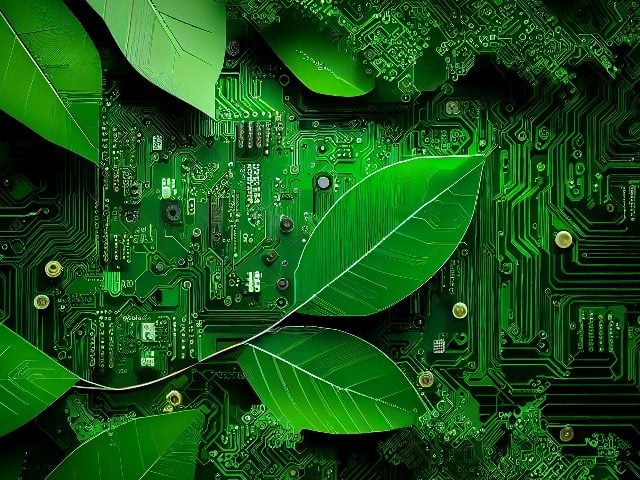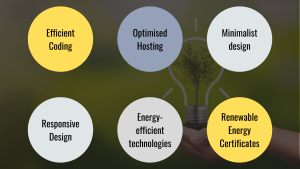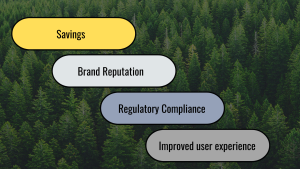Green Web Design: Optimising for Energy Efficiency
Introduction In our increasingly digital world, where websites are not only the face of business but also an integral part of everyday life, the impact of the Internet on the ...

Introduction
In our increasingly digital world, where websites are not only the face of business but also an integral part of everyday life, the impact of the Internet on the environment cannot be ignored. As the Internet expands, so does energy consumption, contributing to carbon emissions and environmental degradation. However, there is a growing movement towards green web design, where designers and developers are prioritising energy efficiency and sustainability in their creations.
Understanding the Environmental Impact
Before delving into green web design practices, it’s important to understand the environmental impact of traditional web design. Websites are hosted on servers that require electricity to run and cool. This electricity often comes from non-renewable sources such as coal or natural gas, resulting in significant carbon emissions. In addition, the data centres that house these servers consume huge amounts of energy, further worsening the environmental footprint.
By some estimates, the Internet’s carbon footprint rivals that of the aviation industry, and it continues to grow as Internet use grows worldwide. This highlights the importance of implementing sustainable practices in web design and development.
Principles of Green Web Design
Green web design involves optimising websites and web applications to minimise energy consumption and reduce their carbon footprint. Here are some basic principles.

- Efficient Coding: Clean, concise code not only improves website performance, but also reduces power consumption. Bloated code requires more server resources to process, resulting in higher power consumption. By following best practices such as minimising HTTP requests, optimising images, and using efficient programming languages, developers can create websites that load faster and use less power.
- Responsive Design: Responsive web design ensures that websites adapt smoothly to different devices and screen sizes. This not only improves the user experience, but also reduces power consumption by eliminating the need for separate mobile and desktop versions of the website. As more and more users access the Internet through mobile devices, responsive design becomes essential for green web design.
- Optimised Hosting: Choosing the right hosting provider and server location can make a big difference in the energy efficiency of a website. Choosing hosting providers that use renewable energy sources or use energy-efficient technologies can help reduce your impact on the environment. Additionally, choosing to locate servers closer to your target audience can minimise latency and improve website performance while reducing energy consumption associated with data transmission.
- Energy-efficient technologies: The use of energy-efficient technologies, such as content delivery networks (CDNs), which cache website content on servers located closer to users, can reduce the distance that data must be transmitted, thus reducing energy consumption. Similarly, implementing browser caching and using compression techniques can further optimise website performance and reduce server load.
- Minimalist design: A minimalist approach to design not only improves aesthetics, but also reduces the complexity of web pages, contributing to faster loading and lower power consumption. By eliminating unnecessary elements and focusing on important content, designers can create visually appealing websites that are environmentally friendly.
- Renewable Energy Certificates (RECs): For websites hosted on servers powered by non-renewable energy sources, purchasing Renewable Energy Certificates (RECs) can help offset carbon emissions. RECs represent the environmental attributes of renewable energy production and can be purchased to support renewable energy projects, thus contributing to the sustainability of web hosting.
Business Benefits for Green Web Design
In addition to environmental benefits, green web design offers several business benefits.

- Savings: Implementing energy-saving practices can save you money in the long run. By optimising website performance and reducing server power consumption, businesses can lower hosting costs and increase profits.
- Brand Reputation: Demonstrating a commitment to sustainability through green web design can enhance a company’s brand reputation and attract environmentally conscious customers. Consumers increasingly prefer green businesses, and incorporating sustainability into web design can help businesses stand out in the marketplace.
- Regulatory Compliance: As environmental regulations become more stringent, businesses may face legal requirements to reduce their carbon footprint. By adopting green web design practices early, businesses can ensure compliance with future regulations and avoid potential fines or penalties.
- Improved user experience: Green web design not only benefits the environment, but also improves the user experience. Websites that load quickly and perform efficiently are more likely to engage users and increase conversions, leading to increased customer satisfaction and loyalty.
Conclusion
As the digital landscape continues to evolve, the need for sustainable web design and development practices has become increasingly urgent. Green web design offers a holistic approach to minimising the environmental impact of websites while ensuring optimal performance and user experience. By adopting energy-efficient technologies, optimising hosting infrastructure, and prioritising sustainability in design, businesses can reduce their carbon footprint and contribute to a greener, more sustainable future for the Internet. As digital stewards, we are responsible for designing and developing websites that not only meet user needs, but also protect the planet for future generations.